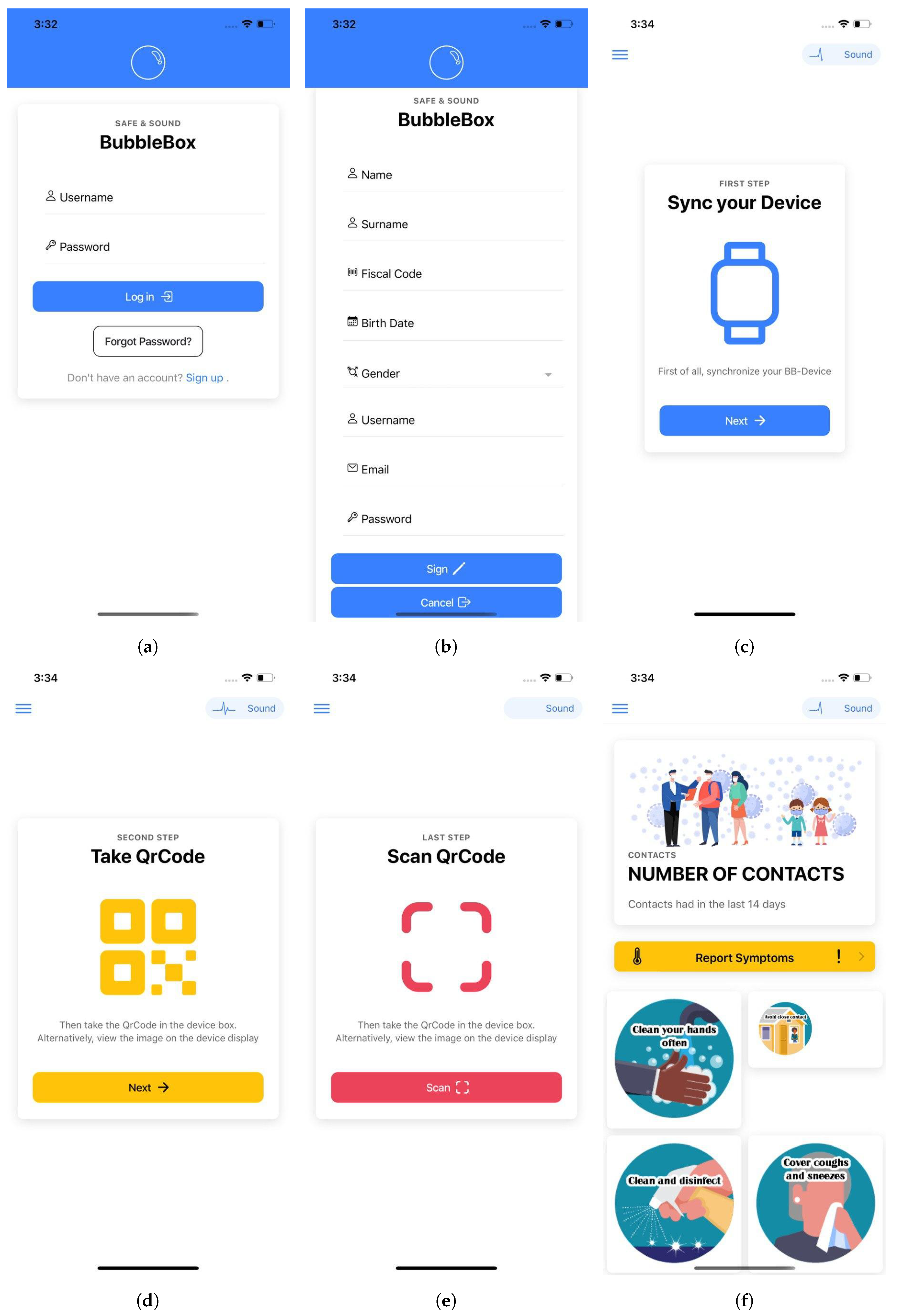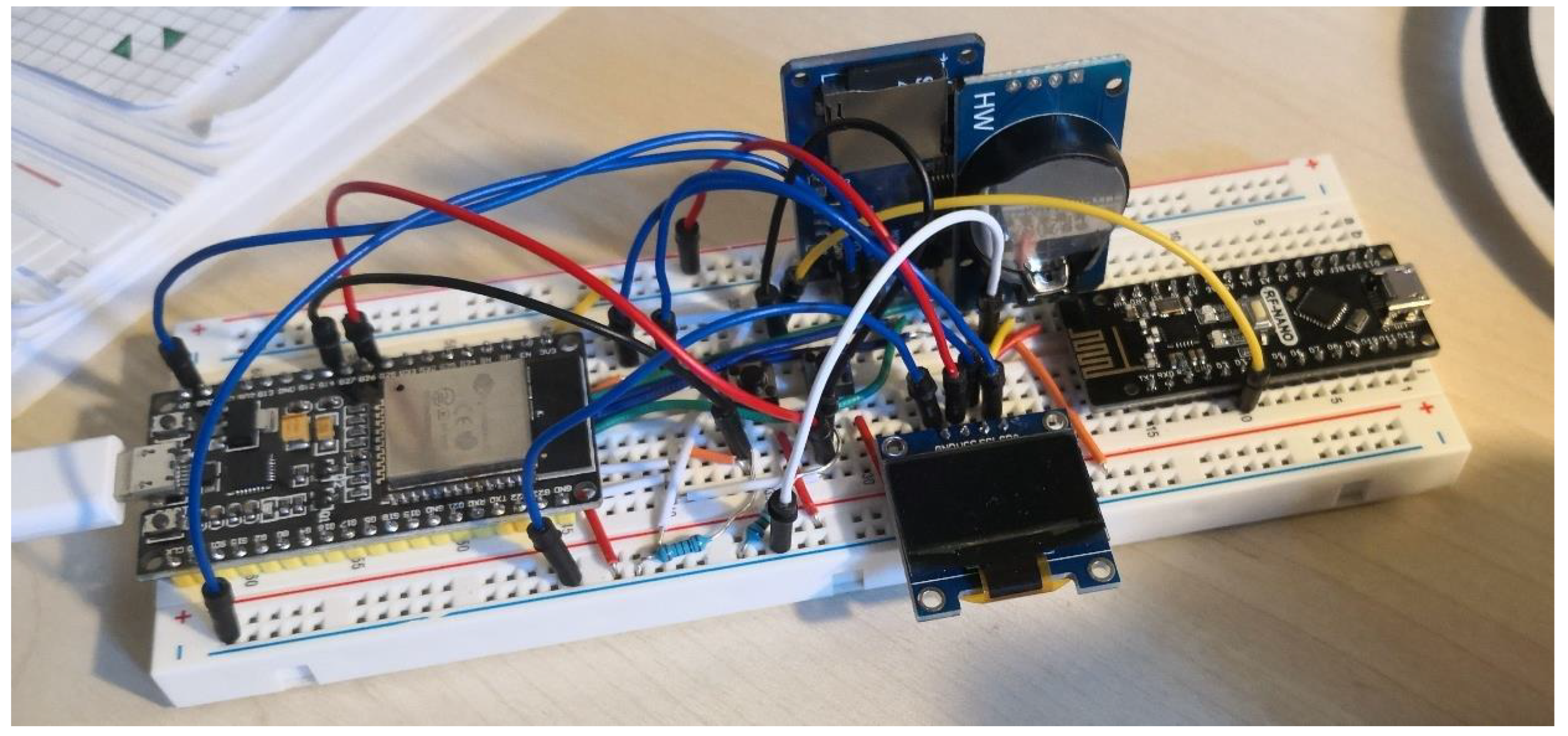An Internet of Things Approach to Contact Tracing—The BubbleBox System
Abstract
1. Introduction
2. Related Works
3. The BubbleBox System
- the citizens, by tracing and notifying potentially contagious contacts when two or more people break the safe social distance;
- health authorities, in managing patients and their status to rapidly check and get in touch with infected, possibly infected, and quarantined patients;
3.1. The BubbleBox Device
- an Arduino Micro (https://store.arduino.cc/arduino-micro) with the NFR24L01 (https://www.sparkfun.com/datasheets/Components/nRF24L01_prelim_prod_spec_1_2.pdf) module to give it Wi-Fi capabilities. The Arduino Micro is the processing core of the device, managing the other components and logging the contacts. The NFR24L01 module allows it to detect other BubbleBox devices in a range of 20 m, in order to wake up the Bluetooth module and detect when the distance with another device is under the safe social distance. In this way, we save the battery life of the device—the consumption of the Arduino Micro with the NFR24L01 is lower than 15 mAh, whilst the Bluetooth module consumes 50 mAh when it is turned on and only 0.05 mAh when it is in deep sleep mode.
- An ESP32 (https://www.espressif.com/en/products/modules) module to give the device Bluetooth Low Energy (BLE) connectivity. The Received Signal Strength Indicator (RSSI) of the detected devices allows to estimate the relative distance and, thus, trace unsafe contacts.
- A RTC DS3231 (https://datasheets.maximintegrated.com/en/ds/DS3231.pdf) module. It is a real time clock which allows us to get the time and date on the device and, thus, the timestamps of the contacts.
- A OLED display (0.96 ′′) used to shows contacts, time, and date to the user. With the display, two buttons allow the user to connect to Wi-Fi networks via WPS or with the smartphone, via BLE.
- A MicroSD card reader, to log the contact data, sent to the system server when a Wi-Fi network is available.
- A Lithium battery (and its charger), to power the device.
- Scan of the area. The Android Micro module, with its NRF24L01, scans a range of 20 m to understand if there are other BubbleBox devices. This preliminary scan is executed with a period of 4 s and allows to save the battery of the device, as this module consumes less power than the ESP32, which stays in deep sleep mode until one or more devices are found.
- BubbleBox device found. When one or more BubbleBox devices are detected, the Arduino Micro wakes the Bluetooth module, that is, the ESP32, from its deep sleep mode.
- Bluetooth turned on. The device information (MAC address, Device name, UUID) becomes available for the Bluetooth scans of the other BubbleBox devices.
- Bluetooth scan and distance detection. The ESP32 module is in charge of scanning the area for other BubbleBox devices and check the distance through RSSI.
- Contact detected. If another device is under the safe social distance (2 m), this has to be considered an unsafe contact.
- Contact logged. The Arduino Micro logs each unsafe contact into its MicroSD card. Using its DS3231 real time clock, the device saves the log <Date, Time, MyId, OtherId> where “MyId” and “OtherId”, in our tests, were the mac address of the ESP32 modules of user’s device and the detected device. In case the ESP32 and the NRF24L01 modules do not detect any other device, the ESP32 module is set back to deep sleep mode.
3.2. The BubbleBox App
- sound, if she/he did not report any symptom or has been involved in any unsafe contact with positive people;
- with symptoms, if she/he reported symptoms and need to be tested by the authorized health staff;
- positive, if she/he has been found positive after medical tests;
- in quarantine, if the medical staff decided that the user should stay in quarantine for being in contact with other positive people.
3.3. The BubbleBox Data Backend
- user data of those users who registered with the app;
- the relation which pairs user data and devices, for the registered users;
- the contacts under the safe social distance detected by the device;
- the symptoms report uploaded by the users, and their status related to the outbreak (sound, positive, in quarantine, with symptoms).
4. Discussion
4.1. Dedicated Device vs. Smartphone
- using the app on the smartphone for the distance estimation and, therefore, to perform the entire tracing would require to have the Bluetooth always turned on. However, this would cause an energy overhead on commodity smartphones, draining the battery [23]. The dedicated device, instead, has its own battery, so the smartphone battery is consumed as per its normal usage.
- A dedicated device can be used also in places were the user normally does not use or does not want to use the smartphone.
- A dedicated device can be used also by children or older adults, and other people or the medical staff can register for them the device using a PC, a smartphone, or a tablet.
4.2. Privacy and Security
4.3. Prototype Implementation
4.4. Cost Analysis
4.5. Limitations
5. Conclusions
Author Contributions
Funding
Conflicts of Interest
References
- Rothan, H.A.; Byrareddy, S.N. The epidemiology and pathogenesis of coronavirus disease (COVID-19) outbreak. J. Autoimmun. 2020, 109, 102433. [Google Scholar] [CrossRef] [PubMed]
- World Health Organization. WHO Coronavirus Disease (COVID-19) Dashboard. Available online: https://covid19.who.int/ (accessed on 16 May 2020).
- Anderson, R.M.; Heesterbeek, H.; Klinkenberg, D.; Hollingsworth, T.D. How will country-based mitigation measures influence the course of the COVID-19 epidemic? Lancet 2020, 395, 931–934. [Google Scholar] [CrossRef]
- Hellewell, J.; Abbott, S.; Gimma, A.; Bosse, N.I.; Jarvis, C.I.; Russell, T.W.; Munday, J.D.; Kucharski, A.J.; Edmunds, W.J.; Sun, F.; et al. Feasibility of controlling COVID-19 outbreaks by isolation of cases and contacts. Lancet Glob. Health 2020, 8, e488–e496. [Google Scholar] [CrossRef]
- Cho, H.; Ippolito, D.; Yu, Y.W. Contact Tracing Mobile Apps for COVID-19: Privacy Considerations and Related Trade-offs. arXiv 2003, arXiv:2003.11511. [Google Scholar]
- Wang, C.J.; Ng, C.Y.; Brook, R.H. Response to COVID-19 in Taiwan: Big Data Analytics, New Technology, and Proactive Testing. JAMA 2020, 323, 1341–1342. [Google Scholar] [CrossRef] [PubMed]
- Singapore Government Agency. Help Speed Up Contact Tracing with TraceTogether. Available online: https://www.gov.sg/article/help-speed-up-contact-tracing-with-tracetogether (accessed on 15 May 2020).
- Italian Ministry for Technological Innovation and Digitalization. Immuni: Tutto Quello Che c’è da Sapere e le Risposte del Dipartimento. Available online: https://innovazione.gov.it/Immuni-tutto-quello-che-ce-da-sapere/ (accessed on 15 May 2020).
- Lewis, D.M.; Leibrand, S. CoEpi: Community Epidemiology in Action. Available online: https://www.coepi.org/ (accessed on 15 May 2020).
- Von Arx, S.; Becker-Mayer, I.; Blank, D.; Colligan, J.; Fenwick, R.; Hittle, M.; Ingle, M.; Nash, O.; Nguyen, V.; Petrie, J.; et al. Covid Watch. Slowing the Spread of Infectious Diseases Using Crowdsourced Data. Available online: https://www.covid-watch.org/covid_watch_whitepaper.pdf (accessed on 15 May 2020).
- Troncoso, C.; Payer, M.; Hubaux, J.-P.; Salathé, M.; Larus, J.; Bugnion, E.; Lueks, W.; Stadler, T.; Pyrgelis, A.; Antonioli, D.; et al. Decentralized Privacy-Preserving Proximity Tracing. Available online: https://github.com/DP-3T/documents (accessed on 2 May 2020).
- Berke, A.; Bakker, M.; Vepakomma, P.; Larson, K.; Pentland, A.S. Assessing Disease Exposure Risk with Location Data: A Proposal for Cryptographic Preservation of Privacy. arXiv 2003, arXiv:2003.14412. [Google Scholar]
- Bell, J.; Butler, D.; Hicks, C.; Crowcroft, J. TraceSecure: Towards Privacy Preserving Contact Tracing. arXiv 2004, arXiv:2004.04059. [Google Scholar]
- Kuhn, C.; Beck, M.; Strufe, T. Covid Notions: Towards Formal Definitions–and Documented Understanding–of Privacy Goals and Claimed Protection in Proximity-Tracing Services. arXiv 2004, arXiv:2004.07723. [Google Scholar]
- Moazzami, B.; Razavi-Khorasani, N.; Dooghaie Moghadam, A.; Farokhi, E.; Rezaei, N. COVID-19 and telemedicine: Immediate action required for maintaining healthcare providers well-being. J. Clin. Virol. 2020, 126. [Google Scholar] [CrossRef] [PubMed]
- Chambers, R.; Gabbett, T.J.; Cole, M.H.; Beard, A. The use of wearable microsensors to quantify sport-specific movements. Sport. Med. 2015, 45, 1065–1081. [Google Scholar] [CrossRef] [PubMed]
- Kos, M.; Kramberger, I. A Wearable Device and System for Movement and Biometric Data Acquisition for Sports Applications. IEEE Access 2017, 5, 6411–6420. [Google Scholar] [CrossRef]
- Bayo-Monton, J.L.; Martinez-Millana, A.; Han, W.; Fernandez-Llatas, C.; Sun, Y.; Traver, V. Wearable sensors integrated with Internet of Things for advancing eHealth care. Sensors 2018, 18, 1851. [Google Scholar] [CrossRef] [PubMed]
- Falcionelli, N.; Sernani, P.; Brugués, A.; Mekuria, D.N.; Calvaresi, D.; Schumacher, M.; Dragoni, A.F.; Bromuri, S. Indexing the Event Calculus: Towards practical human-readable Personal Health Systems. Artif. Intell. Med. 2019, 96, 154–166. [Google Scholar] [CrossRef] [PubMed]
- Bumgarner, J.M.; Lambert, C.T.; Hussein, A.A.; Cantillon, D.J.; Baranowski, B.; Wolski, K.; Lindsay, B.D.; Wazni, O.M.; Tarakji, K.G. Smartwatch Algorithm for Automated Detection of Atrial Fibrillation. J. Am. Coll. Cardiol. 2018, 71, 2381–2388. [Google Scholar] [CrossRef] [PubMed]
- Pirouz, B.; Shaffiee Haghshenas, S.; Shaffiee Haghshenas, S.; Piro, P. Investigating a serious challenge in the sustainable development process: Analysis of confirmed cases of COVID-19 (new type of coronavirus) through a binary classification using artificial intelligence and regression analysis. Sustainability 2020, 12, 2427. [Google Scholar] [CrossRef]
- Shaffiee Haghshenas, S.; Pirouz, B.; Shaffiee Haghshenas, S.; Pirouz, B.; Piro, P.; Na, K.S.; Cho, S.E.; Geem, Z.W. Prioritizing and Analyzing the Role of Climate and Urban Parameters in the Confirmed Cases of COVID-19 Based on Artificial Intelligence Applications. Int. J. Environ. Res. Public Health 2020, 17, 3730. [Google Scholar] [CrossRef]
- Radhakrishnan, M.; Misra, A.; Balan, R.K.; Lee, Y. Smartphones and BLE Services: Empirical Insights. In Proceedings of the 2015 IEEE 12th International Conference on Mobile Ad Hoc and Sensor Systems, Dallas, TX, USA, 19–22 October 2015; pp. 226–234. [Google Scholar] [CrossRef]
- Androulaki, E.; Barger, A.; Bortnikov, V.; Cachin, C.; Christidis, K.; De Caro, A.; Enyeart, D.; Ferris, C.; Laventman, G.; Manevich, Y.; et al. Hyperledger Fabric: A Distributed Operating System for Permissioned Blockchains. In Proceedings of the Thirteenth EuroSys Conference; Association for Computing Machinery: New York, NY, USA, 2018. [Google Scholar] [CrossRef]
- Brooke, J. SUS-A quick and dirty usability scale. Usability Eval. Ind. 1996, 189, 4–7. [Google Scholar]
- Finstad, K. The Usability Metric for User Experience. Interact. Comput. 2010, 22, 323–327. [Google Scholar] [CrossRef]
- Ferretti, L.; Wymant, C.; Kendall, M.; Zhao, L.; Nurtay, A.; Abeler-Dörner, L.; Parker, M.; Bonsall, D.; Fraser, C. Quantifying SARS-CoV-2 transmission suggests epidemic control with digital contact tracing. Science 2020, 368, 6936. [Google Scholar] [CrossRef] [PubMed]
- eHealth Network. Mobile Applications to Support Contact Tracing in the EU’s Fight against COVID-19 Common EU Toolbox for Member States. Available online: https://ec.europa.eu/health/sites/health/files/ehealth/docs/covid-19_apps_en.pdf (accessed on 25 June 2020).




© 2020 by the authors. Licensee MDPI, Basel, Switzerland. This article is an open access article distributed under the terms and conditions of the Creative Commons Attribution (CC BY) license (http://creativecommons.org/licenses/by/4.0/).
Share and Cite
Polenta, A.; Rignanese, P.; Sernani, P.; Falcionelli, N.; Mekuria, D.N.; Tomassini, S.; Dragoni, A.F. An Internet of Things Approach to Contact Tracing—The BubbleBox System. Information 2020, 11, 347. https://doi.org/10.3390/info11070347
Polenta A, Rignanese P, Sernani P, Falcionelli N, Mekuria DN, Tomassini S, Dragoni AF. An Internet of Things Approach to Contact Tracing—The BubbleBox System. Information. 2020; 11(7):347. https://doi.org/10.3390/info11070347
Chicago/Turabian StylePolenta, Andrea, Pietro Rignanese, Paolo Sernani, Nicola Falcionelli, Dagmawi Neway Mekuria, Selene Tomassini, and Aldo Franco Dragoni. 2020. "An Internet of Things Approach to Contact Tracing—The BubbleBox System" Information 11, no. 7: 347. https://doi.org/10.3390/info11070347
APA StylePolenta, A., Rignanese, P., Sernani, P., Falcionelli, N., Mekuria, D. N., Tomassini, S., & Dragoni, A. F. (2020). An Internet of Things Approach to Contact Tracing—The BubbleBox System. Information, 11(7), 347. https://doi.org/10.3390/info11070347






